Pike's Peak
and The
Garden of the Gods
Colorado
Springs, CO
May 6, 2001
On  a
beautiful day in May, I found myself sitting in a trailer park
that backed up against one of America's natural wonders (Garden
of the Gods Park), with yet another wonder (Pike's Peak) visible
to the west, was pretty impressive. The history of Colorado
Springs tells that the area was pretty much up for grabs until
the end of the Civil war. The Indians had it, the white man took
it, there were raids and killing and at least one massacre. Some
gold was found but ran out quickly. In 1868 General William
Palmer fresh from his success in the Civil War, teamed up with an
English adventurer, William Bell, to complete
a
beautiful day in May, I found myself sitting in a trailer park
that backed up against one of America's natural wonders (Garden
of the Gods Park), with yet another wonder (Pike's Peak) visible
to the west, was pretty impressive. The history of Colorado
Springs tells that the area was pretty much up for grabs until
the end of the Civil war. The Indians had it, the white man took
it, there were raids and killing and at least one massacre. Some
gold was found but ran out quickly. In 1868 General William
Palmer fresh from his success in the Civil War, teamed up with an
English adventurer, William Bell, to complete 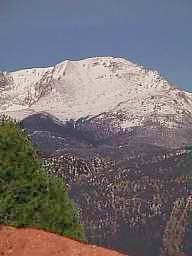 a
survey for the Kansas Pacific Railway. They were enthralled by
the fantastic beauty the area presented along with the numerous
boiling springs that dotted the area. Within four years a health
spa community sprouted, guided by the General who profited
greatly in the process. Over a half century earlier, in 1806, Lt.
Zebulon Pike, while leading a military patrol, discovered a high
mountain which he tried to scale, only to be turned back. It was
subsequently named after him and became known as "Pike's
Peak". This, by far, is the area's most significant
attraction. Starting at around 7000 feet, with an entrance some
twenty miles west of Colorado Springs, the mountain is now part
of the National Park System. In 1893, Katherine Bates was so
impressed with the view from the 14,000 foot summit, she sat down
and penned "America the Beautiful", professing the
greatness of this "Home of the brave and land of the
free". The National Park Service has slightly modified the
description to "Land of the Fee",
a
survey for the Kansas Pacific Railway. They were enthralled by
the fantastic beauty the area presented along with the numerous
boiling springs that dotted the area. Within four years a health
spa community sprouted, guided by the General who profited
greatly in the process. Over a half century earlier, in 1806, Lt.
Zebulon Pike, while leading a military patrol, discovered a high
mountain which he tried to scale, only to be turned back. It was
subsequently named after him and became known as "Pike's
Peak". This, by far, is the area's most significant
attraction. Starting at around 7000 feet, with an entrance some
twenty miles west of Colorado Springs, the mountain is now part
of the National Park System. In 1893, Katherine Bates was so
impressed with the view from the 14,000 foot summit, she sat down
and penned "America the Beautiful", professing the
greatness of this "Home of the brave and land of the
free". The National Park Service has slightly modified the
description to "Land of the Fee",  with the
addition of a $10 a day entrance fee, Welcome to progress! Our
attempt to climb the magnificent piece of real estate was halted
at 8,000 feet by several feet of snow, recently deposited on the
roadway. We learned on our first day in town that snow is related
to elevation. Each day of rain forecast came with a "snow
with the
addition of a $10 a day entrance fee, Welcome to progress! Our
attempt to climb the magnificent piece of real estate was halted
at 8,000 feet by several feet of snow, recently deposited on the
roadway. We learned on our first day in town that snow is related
to elevation. Each day of rain forecast came with a "snow 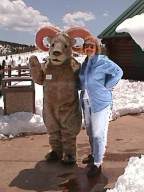 elevation
point". After a rain, for which we had several, we would
look out and the Rockies to the west would be covered with snow,
down to a point. It was quite a strange feeling to leave 60
degree weather and drive into standing snow. Crystal Lake was
magnificent, cloaked in a white blanket that hung like a cape on
Cedars along the bank. But alas like Zebulon Pike himself, we
failed to make the summit. It did help that we were comforted in
our disappointment by a 5 foot big horn Ram at the Lake gift
shop, who was most sympathetic. For those who prefer a scenic
train ride,
elevation
point". After a rain, for which we had several, we would
look out and the Rockies to the west would be covered with snow,
down to a point. It was quite a strange feeling to leave 60
degree weather and drive into standing snow. Crystal Lake was
magnificent, cloaked in a white blanket that hung like a cape on
Cedars along the bank. But alas like Zebulon Pike himself, we
failed to make the summit. It did help that we were comforted in
our disappointment by a 5 foot big horn Ram at the Lake gift
shop, who was most sympathetic. For those who prefer a scenic
train ride,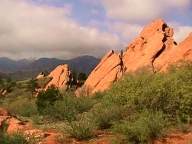 there is the 100 year old Pike's Peak Cog
Railway. This nifty train has a third rail, located between the
two normal tracks. It looked like someone unwound a gear and laid
it flat, with the sprockets facing up. In the center of the
engine is a cog which meshes with the center rail allowing the
train to climb at an angle prohibited to normal trains. Even with
this capability, the train could only climb to 10,000 feet before
it was stopped by the
there is the 100 year old Pike's Peak Cog
Railway. This nifty train has a third rail, located between the
two normal tracks. It looked like someone unwound a gear and laid
it flat, with the sprockets facing up. In the center of the
engine is a cog which meshes with the center rail allowing the
train to climb at an angle prohibited to normal trains. Even with
this capability, the train could only climb to 10,000 feet before
it was stopped by the  snow. Almost as spectacular as the mountain, is
the "Garden of the Gods" city park. The distance from
the back door of the trailer park, to the closest
"unauthorized" park trail, was three tenths of a mile.
These trails are actually on private land that has yet to be
developed. They connect with the official park trails about a
half mile further in. This 1350 acres of really neat stuff was
once the back yard to General Palmer's estate. Donated to the
city in 1909, it is a "Free City Park". No gates, no
rangers, just mile after mile of trails. Oh, and what trails they
were. Tremendous formations of red sandstone that jutted out of
the ground in all manner of shapes, sometimes surrounded by large
flat ledges suitable for standing to get that spectacular
panoramic photograph I just had to have.
snow. Almost as spectacular as the mountain, is
the "Garden of the Gods" city park. The distance from
the back door of the trailer park, to the closest
"unauthorized" park trail, was three tenths of a mile.
These trails are actually on private land that has yet to be
developed. They connect with the official park trails about a
half mile further in. This 1350 acres of really neat stuff was
once the back yard to General Palmer's estate. Donated to the
city in 1909, it is a "Free City Park". No gates, no
rangers, just mile after mile of trails. Oh, and what trails they
were. Tremendous formations of red sandstone that jutted out of
the ground in all manner of shapes, sometimes surrounded by large
flat ledges suitable for standing to get that spectacular
panoramic photograph I just had to have.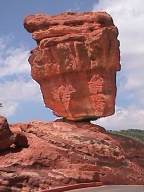 The piece de résistance to this natural
wonderland is "Balance Rock", a massive bolder
teetering precariously on another massive rock structure. There
are also such formations as "Cathedral Mountain" or
"Sleeping Giant" that dot the horizon, no more than 5
miles away. Many of these formations are 300 million years old, a
product of time and erosion. The park runs northward for many
miles. Past the park, continuing in the same direction is Glen
Eyrie, the grand estate that General Parker began in 1868. The
General named it for a golden eagle's nest he found high on a
cliff side. The nest is still there today, though the eagles are
long gone. The name is Scottish and means "valley of the
eagle's nest" The General lived there until his death in
1909, after which the castle manor fell into disrepair as it
passed from person to person. The furnishings were siphoned off
by relatives
The piece de résistance to this natural
wonderland is "Balance Rock", a massive bolder
teetering precariously on another massive rock structure. There
are also such formations as "Cathedral Mountain" or
"Sleeping Giant" that dot the horizon, no more than 5
miles away. Many of these formations are 300 million years old, a
product of time and erosion. The park runs northward for many
miles. Past the park, continuing in the same direction is Glen
Eyrie, the grand estate that General Parker began in 1868. The
General named it for a golden eagle's nest he found high on a
cliff side. The nest is still there today, though the eagles are
long gone. The name is Scottish and means "valley of the
eagle's nest" The General lived there until his death in
1909, after which the castle manor fell into disrepair as it
passed from person to person. The furnishings were siphoned off
by relatives 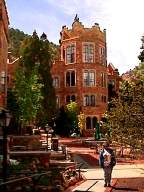 until the walls were bare. Oil tycoon George
Strake bought the estate in 1938 and lived there until the great
flood of '47 destroyed most of the holdings. In 1950 he was
approached by a Christian religious order known as The
Navigators. Being a devout man, he reduced the cost of the
holding until the Navigators were able to purchase it and hundred
of acres around it. It is now a conference center and retreat.
The Navigators have done much to restore the old grandeur to the
castle. The ground floor is open for tourists, as are the
grounds. Now, well cared for, it reflects a stately and serene
atmosphere in which to study and reflect.
until the walls were bare. Oil tycoon George
Strake bought the estate in 1938 and lived there until the great
flood of '47 destroyed most of the holdings. In 1950 he was
approached by a Christian religious order known as The
Navigators. Being a devout man, he reduced the cost of the
holding until the Navigators were able to purchase it and hundred
of acres around it. It is now a conference center and retreat.
The Navigators have done much to restore the old grandeur to the
castle. The ground floor is open for tourists, as are the
grounds. Now, well cared for, it reflects a stately and serene
atmosphere in which to study and reflect.
When including the sister city of Manitou Springs which abuts the
western edge of Colorado Springs, the list of adventures
available is increased. Here we found the Manitou Cliff Dwellings
which present a unique look at Native American culture. We were
able to wander through the preserve and explore the fascinating
architecture of the ancient Anasizi Indians. There were two
museums which featured cultural displays of prehistoric
Southwestern Indians. If this isn't enough, hidden in the middle
of Manitou Springs is Miramont
Castle. Built by a
French Catholic Priest for his mother. It was used by the Church
for a time after it's intended guest returned to France and now
stands as a museum for the area's artifacts. It includes a
magnificent collection of dolls and doll houses, along with many
items from an older Catholic order. Still there are other things
too numerous to mention. A great Pioneer museum is free to the
public and of course the Air Force Academy makes its home here.
Even with a 7 day layover it was impossible to see it all. This
is really quite a place.
*** THE END ***
